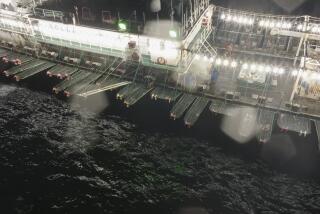He Fills Tall Orders From a Bygone Era : Sailor Builds Custom Parts in His Garage
- Share via
It’s midnight, and the only sound in this Cardiff neighborhood is the whir of a wood lathe and the buzz of a saber saw. Inside a garage, a man wearing a captain’s cap moves slowly but deliberately from machine to machine.
The faint smell of Edgeworth tobacco rises in a wisp from his pipe and blends with the smell of freshly cut wood. That, and a thick white beard, give Baron Thomas the look of an old sea captain preparing for a voyage on the morning tide.
Thomas, at 48, is a throwback to an age of iron men and wooden ships. He will work most of this night making belaying pins, hearts, bull’s-eyes and deadeyes, all necessary rigging on tall ships.
For the past 14 years, he has custom-built parts for tall ship restorations and replicas. His projects have included the Star of India and the Disneyland tall ship the Susquehanna. He has had a hand in outfitting dozens of schooners and square-rigged sailing ships along the east and west coasts of the Americas.
His job is a lonely one and, for the most part, appreciated only by those familiar with sailing history or traditional shipbuilding.
Now he is working on filling an order for the tall ship Niagara, a replica of a flagship from the War of 1812. He must finish 24 tiny deadeyes--used for setting up rigging or shrouds on old sailing ships--by morning, then put them on a jet for Lake Erie, where the Niagara is waiting. The ship won’t be completely rigged until July, and meanwhile Thomas is working night and day to fill the orders.
His garage is cluttered with rough lumber, four lathes, a milling machine, band saws, table saws and a dusty pile of finished products in the corner.
In the back yard are several large timbers. “It takes eight large men just to move one piece from the yard to my workshop,” said Thomas. “Each tree is 300 years old.”
Thomas’ home has the feel of a nautical museum. An 800-pound sea anchor sits upright in his front yard, and a small, 140-year-old ship’s boat sits in the rear. He admits to fantasizing about being born a century or two earlier.
In addition to crafting wood parts for old ships, he builds 18th- and 19th-century cannons for nautical projects. These are working, firing cannons and come with caisson, firing tools and shot. He serves as cannoneer aboard the H.M.S. Dolphin, for which he built the cannons.
Thomas’ association with ships and the sea has been lifelong.
He served aboard his father’s wooden schooner as soon as he could walk, and eventually became a first mate, capable of repairing radios, engines, ripped sails and, of course, wooden hardware. Baron was buying and rebuilding his own boats at age 7.
He is the saltiest of three brothers and a seagoing father. His father once owned the charter boat Rendezvous, which plied San Diego waters for most of a decade.
There has been a kind of swashbuckler mystique about the family. Baron was named after his father’s fencing club, the Barons. Brother Drake was named after Sir Francis Drake, the seagoing explorer. And brother Lance was named after Lancelot of the Round Table.
Thomas and his father still sail on visiting schooners and tall ships. It’s not unusual for him to break into song at sea, and he usually wears a sailor’s uniform from a century past, “just for effect.”
While still a teen-ager, Thomas began a 25-year association with the Scripps Institution of Oceanography that took him around the world many times.
Like seafarers of old, he kept detailed logs while at sea. In his own script are descriptions of every sighting of land, or ship, or natural phenomena by longitude and latitude during his quarter century at sea. Throughout the books are his precise pen and ink nautical drawings.
The ships’ logs tell the fears of a young boy at sea, and, eventually, the thoughts of a mature adult who began to understand what he saw.
In 1971, Thomas was injured in a car accident. He lost his right leg, and with that came an end to his career as an oceanographer.
“I wish I had something more nautical to say about losing my leg,” he said. “I certainly could have invented a better story than ‘car accident.’ ”
A few years after his accident, he began woodworking in earnest. It wasn’t long before his talent caught the attention of old friend Melbourne Smith, a ship builder and designer.
There is a demand for ships’ gear from all over the world, but Thomas has worked almost exclusively for Smith on tall ship replicas.
“There’s no one on the continent like Baron,” says Smith.
More to Read
Sign up for The Wild
We’ll help you find the best places to hike, bike and run, as well as the perfect silent spots for meditation and yoga.
You may occasionally receive promotional content from the Los Angeles Times.






